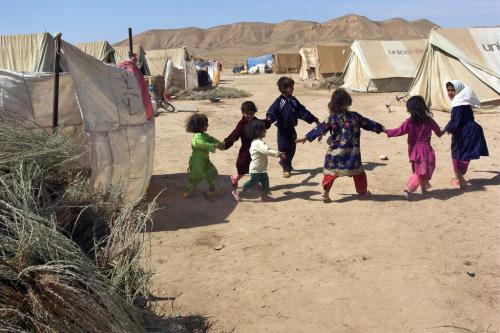Conflict-related child deaths hit new high in Afghanistan, UN warns
Deeply concerned by the continued increase in conflict-related child deaths in Afghanistan, the UN Assistance Mission in the country (UNAMA) has urged parties to the conflict to take immediate measures to reduce harm.

Children play in the Sosmaqala Internally Displaced Persons (IDP) Camp in northern Afghanistan. The camp is comprised of returned Afghans following many years as refugees in neighbouring Iran. 30/Aug/2009. Sar-e-Pul, Afghanistan.
“I was appalled to hear that an unexploded mortar round killed five boys from the same family” on Sunday, said the Secretary-General’s Special Representative for Afghanistan, Tadamichi Yamamoto, in a news release issued on May 15.
“The children were playing outside their home […] A family destroyed in seconds – this horror is just one of too many incidents documented at the onset of this fighting season,” he added.
The first four months of 2017 witnessed the highest recorded number of child civilian casualties resulting from conflict-related incidents in Afghanistan, including the highest number of children killed, for the same comparable period since the Mission began documenting cases.
Between 1 January and 30 April 2017, UNAMA preliminarily recorded 283 child deaths, a 21 per cent increase compared with the same period in 2016. Children are killed by explosive remnants of war in civilian-populated areas and in ground fighting.
Many of the more than 700 children injured have suffered life-changing injuries, including loss of limbs, as well as significant and lasting trauma such as witnessing the death of siblings, parents, destruction to their homes or displacement.
UNAMA again urged parties to the conflict to prioritize the protection of children and welcomed the commitment of the Government to formally ratify Protocol V to the 1980 Convention on Conventional Weapons.
The Mission urged all parties to the conflict to commence marking, clearing, removing and destroying explosive remnants of war left behind from fighting in areas under their territorial control.
Source:United Nations
- 225 reads
Human Rights
Ringing FOWPAL’s Peace Bell for the World:Nobel Peace Prize Laureates’ Visions and Actions

Protecting the World’s Cultural Diversity for a Sustainable Future

The Peace Bell Resonates at the 27th Eurasian Economic Summit

Declaration of World Day of the Power of Hope Endorsed by People in 158 Nations

Puppet Show I International Friendship Day 2020

